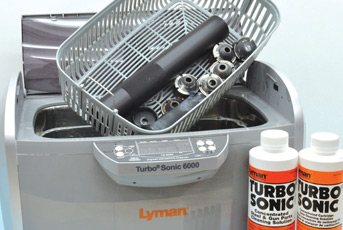Lyman Turbo Sonic 6000 cleaner
- By Chris Parkin
-
0
 Comments
Comments
- Last updated: 22/11/2016

Cleaning brass cases with an ultrasonic bath has long been a weapon in the armoury of reloaders. As well as small units designed for cases alone in various quantities, Lyman has now introduced a 6-litre model that will clean gun parts too and although mainly aimed at the pistol market, what roles can we apply it to?
Having never owned or used an ultrasonic cleaner, I was keen to cast an objective first glance on the principle and started out following the unit’s comprehensive instructions to clean some lubed and resized .308 cases. Using Lyman’s case cleaning solution I decided on the heavier duty mixture of 20:1 making up 4 litres of water-based solution and filling the bath.
EASY 200
The first stage with a new batch of fluid is to `de-gas` the mixture which helps to dissolve the cleaning fluid and prevent air bubbles forming which will hamper effectiveness. The 320 x 200 x 100mm bath easily handled 200 medium-sized rifle cases such as these. Ceramic heaters are controlled by the waterproof buttons and with the tank set at 40° C, I ran a 5 minute cycle.
Inside the bath a tray is supplied that allows removal and drainage of the contents and after a quick look beneath the folding lid I decided to add another 10 minutes for a total 15 minute run. Judging the cases as good as they would get I used the tray to dunk and rinse the contents in clean water before tapping out all the drips and leaving to air dry overnight. After drying, they were 90% clean both externally and internally and ready to reload with no further work. Some water marking remains and de-ionised water can be used in the process, but I was happy with the results even though I am used to the olished finish from the tumbler. A defined `method` is up to user preferences for long term use.
DON’T SPILL
To empty the bath, a tap and hose drain the solution into a suitable storage container for future use and. I went on to mix some Gun Parts cleaner and gave the unit a really tough test, a disassembled sound moderator. Stainless steel baffles get the soot and dirt baked onto them at high temperature in a mod and with another 20:1 mix, but this time heating the water to 60°. I gave the components 30 minutes to see how things went.
The dirt did lift but being baked on, this is perhaps a step too far where the design is more for de-greasing and lighter fouling. But given time, dirt was still being lifted and the clean solution did come out black so had been working. Further tests on reloading dies, a trigger unit and some action components along with some chainsaw bits proved the unit’s worth for oily parts with deposited rather than baked on dirt and I think the moderator was a step too far.
FOR
A versatile cleaning tool with widespread uses
AGAINST
Emptying after each use is mandatory
VERDICT
It isn’t the be all and end all, but a helpful addition to any workshop
